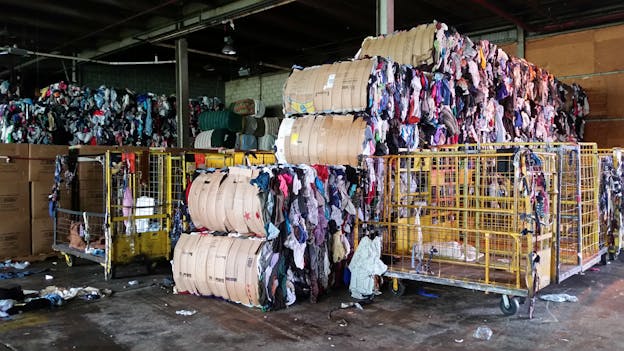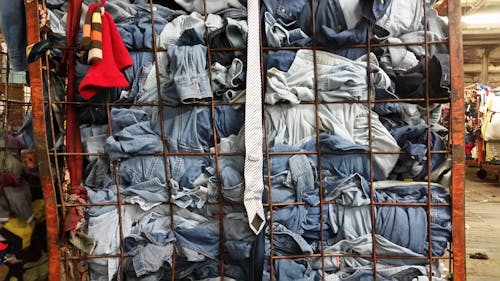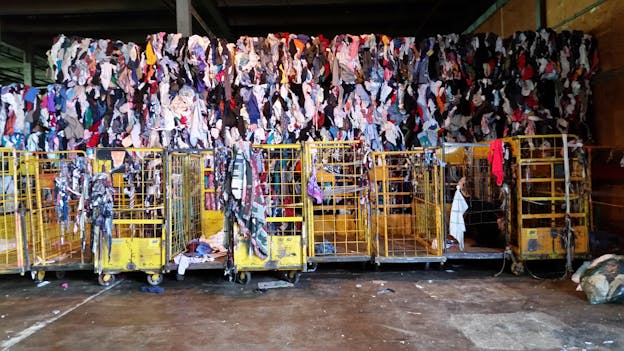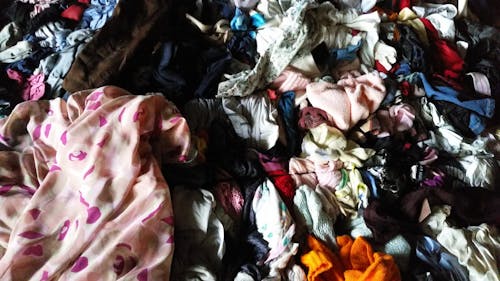“These are the thousand-pound bales,” Michael Zweig says, gesturing to towering stacks of multi-colored compressed cubes of familiar floral prints, stripes, plaids, and graphic T-shirts stacked at inhuman scale. It’s a hot summer day, and the un-airconditioned factory retrofitted as a used textile processing plant feels dusty and sticky at the same time. Wearing a yellow tank top and cut off shorts, Zweig puffs away on a melon-flavored vape as he explains how the clothes in the bales end up here. “People think if you donate your coat to a charity you’re giving it to a poor person,” Zweig continues. But it’s more likely to end up at a place like this one in Roselle, New Jersey.
The average American throws away 68 pounds of clothing each year. There’s just too much of it, more than anyone can give away or sell in charity thrift shops. While the sorting industry dates back to at least the 1930s, and the collection and resale of rags in America goes back even further, the recent increase in disposable fashion has created a demand for facilities to process used clothing. Organizations will sell donations to facilities like the one where Zweig works for around 25 cents a pound. The clothes are then sorted on an industrial scale and usually end up one of three places: recycled into rags and wiping cloths, baled and shipped to the developing world, or, for the items deemed the most valuable, sold to vintage and consignment stores.
Zweig runs the vintage department at Romerovski Corp, one of these processing facilities, called rag yards or rag houses. In one corner of the aging 25,000 square-foot former factory, Zweig heads a team of pickers—mostly Hispanic women working for minimum wage—who spend eight-hour days dividing Old Navy from J. Crew, concert t-shirts from hippie chic pieces. I watch Zweig scan through a pile of blouses. “Cheap, cheap, cheap, decent, good, cheap,” he chants as he sorts the items into their corresponding categories.

By far, the most common labels here that I see are Forever 21 and H&M, fated for the cheap pile. “Nobody is stupid enough to buy Forever 21 second-hand,” notes Zweig. No one in the developed world, anyway. Even so, quality and original ticket price aren’t the only criteria Zweig uses to judge an item’s resale value. “It has to do with how hip it is too,” he explains. Thinking about the clientele that shop at most of the vintage and consignment stores Zweig sells to, he knows that “people want to buy TopShop more than they want to buy Trina Turk.” And then there are the off-beat pieces that catch the eye of Zweig’s best pickers.
In the Torah, there’s a decree against garments mixing wool and linen—shatnez, in Hebrew—and likewise, the rag yard has a logic of sameness and difference to its operations. Denim is separated from sweaters. Cashmere is separated from blended knits. Polyester dresses are separated from silk ones. Even the employees are grouped. The Haitian workers in one department, the Hispanic workers in another. There’s a parking lot for the factory workers and another for the office staff. Zweig, however, is an exception with liminal status, capable of code-switching and moving freely through the factory’s various factions.
Zweig was born and raised in an Orthodox Jewish community in Midwood, Brooklyn. He met the rag yard owner’s son at school in Israel where they were both studying, but in his 20s left the fold, dropping out of law school and pursuing a publishing program at Columbia. These days, he’s traded his yarmulke for vintage Hawaiian shirts and lives in Red Hook with a roommate. At Romerovski Corp, he’s allowed to park in the same parking lot as the owners and the other Jewish office workers; his mother is still thrilled he works somewhere where he gets off early on Fridays, the Sabbath.
Watching Zweig separate Elie Tahari from Old Navy, faux fur from the real thing, shatnez comes to mind. In the Jewish community, Zweig told me, there are even experts who look under a microscope to certify there’s no forbidden mixing in a garment. But he doesn’t live in that world anymore. For his Orthodox bosses, Zweig’s value is in his knowledge. He knows what’s trending among the fashionistas shopping at vintage boutiques, and therefore what to sell and for how much. After a conversation with the owner’s son, Zweig gestures to a box of clothes he’s curated for a particular Brooklyn vintage boutique: “He wouldn’t have any idea how to sell these.”

“Vintage has changed a lot, or what people call vintage,” Zweig says. A lot of what Romerovski sells in their vintage department is really name-brand contemporary clothing. In a shipment he was packing up for a vintage shop in Asheville, North Carolina, I spied a pair of Rag and Bone skinny jeans and a Burberry trench coat. It was the same mix of modern and vintage you’d expect to find at a store like Beacon’s Closet or Buffalo Exchange.
In recent years, vintage merchandise has become less static, following its own trends, styles that ebb and flow. Rather than a consistent stock of costume-y 1950s dresses and 1970s fringed vests, as was common 15 years ago, vintage has become more wearable—more attuned to popular tastes. “Three or four years ago, we were selling lots of these 1980s patterned dresses that were easy to wear,” noted Zweig. This year, he’s looking out for brands like Espirit and Tommy Hilfiger that are now enjoying a certain cachet on the secondhand market. “The 90s stuff,” he finishes. Another change: Big retailers like American Apparel, Urban Outfitters, and Reformation have begun to sell vintage clothing on a larger scale—and Zweig has sold to all three of them.
These retailers target their wares at the same hypothetical consumer as the fast fashion businesses—Forever 21, H&M, and Zara—but, in part, they’re sourcing from rather than adding to the glut of used clothes. American Apparel, already known for its socially-conscious mandate of exclusively manufacturing in the U.S., introduced their vintage program in 2007 and expanded it in 2010. Urban Outfitters launched its vintage line “Urban Renewal” in 2008. And a year later, Reformation was founded with an eco-friendly ethos, adopting vintage as part of its model right away and manufacturing its new clothes with recycled materials and fabrics that have a lower environmental footprint.

“Vintage makes up about 10 percent of our business,” Reformation founder and CEO Yael Aflalo told me. That’s ten percent of a lot of business. In 2014, the retailer reported revenues of over $25 million. They sell items like vintage high-waisted denim for $138 and altered military jackets for $158, and boast celebrity customers like Taylor Swift, who’s been spotted shopping in their stores and showing off their clothes on Instagram. The factories for Reformation’s new clothes are vertically integrated, meaning the company owns the facilities where their manufacturing takes place rather than contracting the work out; for their vintage program, though, they buy from rag houses.
With regard to the vintage and recycled fashion market, the business decisions these larger retailers are making have had reverberations across the industry. “Over the past few years we have found demand for vintage increasing. We see greater demand compared to seven to ten years ago,” says Eric Stubin, president and CEO of Trans-Americas, another sorting facility based in New Jersey. He attributes this, in part, to major brands that are bringing vintage to their customers. He refused, though, to disclose his particular clients.
On the worker side, the jobs sorting and grading clothes aren’t glamorous—it’s factory work. The employees at Romerovski Corp. share a union, Local 528, with workers in other miscellaneous manufacturing industries in New York and New Jersey. To better understand the specifics of the rag yard industry, however, Zweig recently visited some other textile processing and grading facilities in Texas. “I had fantasies of some of them looking different,” he said, compared to Romerovski Corp, which is housed in a hundred-year-old warehouse without air-conditioning, sporting visible wear and tear. “You can have a more modern facility, but it’s still just fucking rags everywhere.”

While it’s hard to know how many facilities like this there are across America, one group does make it their business to pay attention to the rag industry: Secondary Materials and Recycled Textiles (SMART), the trade association for the for-profit secondary textiles industry. Its members include sorting and grading facilities, collection bin operators, fiber conversion processors, and rag manufacturers. The agency has about 150 members (mostly in the U.S.) and estimates there are an additional 200 to 300 businesses in the country who aren’t members, according to SMART Communications Strategist Josie Hankey.
Reformation, which markets itself as environmentally and socially-conscious, has a stake in making sure the facilities they buy from meet certain standards. The company asks suppliers that sell them at least $1,000 to sign a code of conduct agreement; for suppliers that sell them more than $10,000 of merchandise, they do regular audits. “We get a third party to go in and vet them, and then if somebody doesn’t achieve compliance, they get 30 days to rectify what was wrong,” Aflalo, the CEO, explains. “Your mind might jump to child labor, but it’s nothing like that. It’s usually small things—you know, you’re supposed to do a ten-minute break every two hours and they’re doing it every two and half hours. It’s very detailed.”

The success of companies like Reformation is perhaps promising from an environmental and labor-standard perspective, but outsourcing continues to dictate the norms of the textile industry. Cheap labor costs in China and Bangladesh sustain the unsustainable practices of big retailers like Forever 21 and H&M—and then, after being discarded, their miniskirts and tank tops reach the end of their lives in markets in Africa and South America. Sorting facilities, too, are following suit. “There is a tendency now, like all kinds of low-skill manufacturing tasks, for the sorting to follow lower labor costs,” notes Pietra Rivoli, Georgetown finance and international business professor, author of The Travels of a T-Shirt in the Global Economy. “The big players in the industry are now in South East Asia.” There, as with the many other places around the world where companies outsource their labor, safety standards and wages are usually lower.
And while the fact that big retailers getting into vintage can potentially popularize more sustainable shopping practices on a large scale, changes to the vintage industry don’t always bode well for independent sellers.
Diane, a first-generation Polish woman in her 60s, who buys from Zweig as well as from estate sales, hocks her vintage clothes, bags, and jewelry at the Hell’s Kitchen flea market on Saturdays and Sundays. She’s there every weekend with her husband, who lost his factory job three years ago when the L'Oreal factory moved from New Jersey to Mexico. Adding to the couple’s financial stresses, business at the flea market has slowed in recent years. “A couple years ago it started getting worse,” says Diane. “Last year wasn’t as bad as it was this year.” She laughs, though, adding, “You can’t be mad.”
Diane knows she’s competing directly with the newer Brooklyn Flea, where a lot of other small vendors have moved. But indirectly, she’s also up against those big retailers who’ve added vintage offerings to their closets. I’m standing near her booth when someone tries to barter with her over a purse. “I can’t go less than 20, hon,” she says, adding matter of factly, “or else I won’t be making anything.”
Reformation was founded in 2009, and not 2008 as originally stated. This article has been updated to reflect the change.
